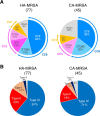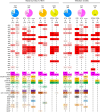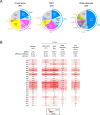Genomic characterization of Staphylococcus aureus isolated from patients admitted to intensive care units of a tertiary care hospital: epidemiological risk of nasal carriage of virulent clone during admission
- PMID: 38709078
- PMCID: PMC11237438
- DOI: 10.1128/spectrum.02950-23
Genomic characterization of Staphylococcus aureus isolated from patients admitted to intensive care units of a tertiary care hospital: epidemiological risk of nasal carriage of virulent clone during admission
Abstract
We conducted a molecular epidemiological study of Staphylococcus aureus using whole-genome sequence data and clinical data of isolates from nasal swabs of patients admitted to the intensive care unit (ICU) of Hiroshima University hospital. The relationship between isolate genotypes and virulence factors, particularly for isolates that caused infectious diseases during ICU admission was compared with those that did not. The nasal carriage rates of methicillin-resistant S. aureus (MRSA) and methicillin-susceptible S. aureus (MSSA) in patients admitted to the ICU were 7.0% and 20.1%, respectively. The carriage rate of community-acquired (CA)-MRSA was 2.3%, accounting for 32.8% of all MRSA isolates. Whole-genome sequencing analysis of the MRSA isolates indicated that most, including CA-MRSA and healthcare-associated (HA)-MRSA, belonged to clonal complex (CC) 8 [sequence type (ST) 8] and SCCmec type IV. Furthermore, results for three disease foci (pneumonia, skin and soft tissue infection, and deep abscess) and the assessment of virulence factor genes associated with disease conditions [bacteremia, acute respiratory distress syndrome (ARDS), disseminated intravascular coagulopathy (DIC), and septic shock] suggested that nasal colonization of S. aureus clones could represent a risk for patients within the ICU. Particularly, MRSA/J and MSSA/J may be more likely to cause deep abscess infection; ST764 may cause ventilation-associated pneumonia, hospital-acquired pneumonia and subsequent bacteremia, and ARDS, and tst-1-positive isolates may cause DIC onset.IMPORTANCENasal colonization of MRSA in patients admitted to the intensive care unit (ICU) may predict the development of MRSA infections. However, no bacteriological data are available to perform risk assessments for Staphylococcus aureus infection onset. In this single-center 2-year genomic surveillance study, we analyzed all S. aureus isolates from nasal swabs of patients admitted to the ICU and those from the blood or lesions of in-patients who developed infectious diseases in the ICU. Furthermore, we identified the virulent clones responsible for causing infectious diseases in the ICU. Herein, we report several virulent clones present in the nares that are predictive of invasive infections. This information may facilitate the design of preemptive strategies to identify and eradicate virulent MRSA strains, reducing nosocomial infections within the ICU.
Keywords: ARGs; ICU; Staphylococcus aureus; VFGs; genomic sequence.
Conflict of interest statement
The authors declare no conflict of interest.
Figures







Similar articles
-
Clonal complexes and virulence factors of Staphylococcus aureus from several cities in India.BMC Microbiol. 2012 May 1;12:64. doi: 10.1186/1471-2180-12-64. BMC Microbiol. 2012. PMID: 22548694 Free PMC article.
-
Antibiotic susceptibility and genomic variations in Staphylococcus aureus associated with Skin and Soft Tissue Infection (SSTI) disease groups.BMC Infect Dis. 2016 Jun 10;16:276. doi: 10.1186/s12879-016-1630-z. BMC Infect Dis. 2016. PMID: 27287530 Free PMC article.
-
[Investigation of SCCmec types and Panton-Valentine leukocidin in community-acquired and nosocomial Staphylococcus aureus strains: comparing skin and soft tissue infections to the other infections].Mikrobiyol Bul. 2012 Jul;46(3):341-51. Mikrobiyol Bul. 2012. PMID: 22951646 Turkish.
-
Molecular Epidemiological Features of Methicillin-Resistant Staphylococcus aureus in Japan.Biol Pharm Bull. 2025;48(3):196-204. doi: 10.1248/bpb.b23-00685. Biol Pharm Bull. 2025. PMID: 40024689 Review.
-
Community-associated meticillin-resistant Staphylococcus aureus infections: epidemiology, recognition and management.Drugs. 2009;69(6):693-716. doi: 10.2165/00003495-200969060-00004. Drugs. 2009. PMID: 19405550 Review.
Cited by
-
Skin Infections Caused by Panton-Valentine Leukocidin and Methicillin-Susceptible Staphylococcus aureus in Child, Japan.Emerg Infect Dis. 2025 Jun;31(6):1227-1230. doi: 10.3201/eid3106.241955. Emerg Infect Dis. 2025. PMID: 40439546 Free PMC article.
-
Staphylococcus aureus ST764-SCCmecII high-risk clone in bloodstream infections revealed through national genomic surveillance integrating clinical data.Nat Commun. 2025 Mar 19;16(1):2698. doi: 10.1038/s41467-025-57575-2. Nat Commun. 2025. PMID: 40108131 Free PMC article.
References
-
- Ministry of Health, Labour and Welfare, Japan nosocomial infections surveillance . Public information intensive care unit (ICU) division (annual report 2010-2018). Accessed 14 March 2022. https://janis.mhlw.go.jp/report/icu.html.
-
- Tsuzuki S, Matsunaga N, Yahara K, Gu Y, Hayakawa K, Hirabayashi A, Kajihara T, Sugai M, Shibayama K, Ohmagari N. 2020. National trend of blood-stream infection attributable deaths caused by Staphylococcus aureus and Escherichia coli in Japan. J Infect Chemother 26:367–371. doi:10.1016/j.jiac.2019.10.017 - DOI - PubMed
-
- Chan JD, Dellit TH, Choudhuri JA, McNamara E, Melius EJ, Evans HL, Cuschieri J, Arbabi S, Lynch JB. 2012. Active surveillance cultures of methicillin-resistant Staphylococcus aureus as a tool to predict methicillin-resistant S. aureus ventilator-associated pneumonia. Crit Care Med 40:1437–1442. doi:10.1097/CCM.0b013e318243168e - DOI - PubMed
-
- Warren DK, Guth RM, Coopersmith CM, Merz LR, Zack JE, Fraser VJ. 2007. Impact of a methicillin-resistant Staphylococcus aureus active surveillance program on contact precaution utilization in a surgical intensive care unit. Crit Care Med 35:430–434. doi:10.1097/01.CCM.0000253813.98431.28 - DOI - PubMed
MeSH terms
Substances
Grants and funding
LinkOut - more resources
Full Text Sources
Medical

